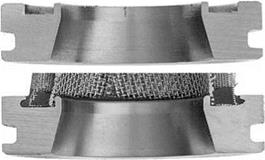Filter elements for hydraulic flight regulation systems (Figures 7.73 and 7.74) usually consist of a metal casing with a glued-in filter. The adhesive bond must be resistant to temperatures in excess of 150 °C. Failure of the bond and loosening of the filter from its seating allows the fluid and included debris to bypass the filter. In hydraulic systems, the release of contaminants represents a severe risk because it may cause the blockage of servo valves and total failure of the hydraulic control systems. When operating the filter it is important to note that there is a possibility of short-term pressure surges in the opposite flow direction.
|
Figure 7.73 Incorrect design of a bonded joint in filter elements. |
In several filter elements used for aeronautical applications, the filter was found to be loosened due to the failure of an adhesive bond. Initially, only the filter elements of the defective type were available for failure examination. This version had been used generally for repairs owing to availability of stock, and such use would indeed have been continued for an extended period of time. In this version, the filter was bonded into a slot in a base plate, but as no adhesive residues were found in the slot an inappropriate surface preparation ofthe stainless steel base plate was assumed to be the cause of the failure (Figure 7.75).
The filter was adhesively bonded with a silica-filled, bis-phenol-A-based epoxy resin adhesive. The role of the filling was to reduce the coefficient of expansion and improve the behavior of the adhesive under thermal cycling.
|
|
|
Figure 7.75 Base plate with slot for the filter bonding. |
When the manufacturer was informed about the design problems of the bonded joint, a new version of the same filter was delivered. Although, visually the filter elements were of identical construction, the strength of the bonded joint was much greater. The new version of the filter elements could not be separated from the base plate without destruction. The bonding of the upper filter cap broke at a force of 786 N, whereas with the former filter elements the bond had detached from the slot of the base plate at a force of only 211 N. This improvement in bond strength of the new version was the result of a design modification, which made it more suitable for bonding under critical conditions. The design modification had added an undercut for mechanical locking as a fallback position. Only the undercut and the added shape support of the adhesively bonded joint design could prevent uncontrolled bond separation in the case of reverse-pressure surges. Under such load conditions, the problem would not have been effectively addressed solely by improving the surface preparation of the stainless steel base plate.
7.8.8
 2 ноября, 2015
2 ноября, 2015  Pokraskin
Pokraskin 


 Опубликовано в рубрике
Опубликовано в рубрике 